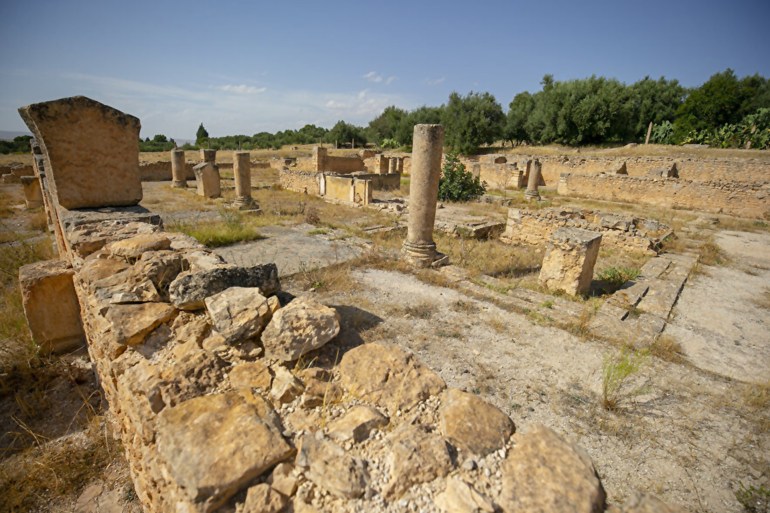About 10 km from the city of Dahmani in the governorate of El Kef, northwest of Tunisia, the ruins of the archaeological site of Tiberos stand erected to tell the history of a city over which nations and civilizations have succeeded since prehistoric times.
The place, which is now called "Medina" (a diminutive of the word city), dates back to the reign of the second Roman Emperor Tiberius (reigned between 14 and 37 AD), and was a refuge for wealthy Phoenician families who fled from the oppression of the Romans.
Tiberos is about 190 km from the capital Tunis, a Numidian village (relative to the ancient Berber kingdom of Numidia in North Africa) that came under the influence of the Carthage Empire at the end of the third century BC, located on the road between Carthage and Tebessa (in Algeria), and flourished during the reign of the Roman Emperor Hadrian (Ruled between 117 and 138 AD).
Its ruins, which extend over an area of two hundred hectares, indicate the adoption of urban planning since ancient times, and when the Romans settled it, they made it a large city and an important commercial center.
The representative of the National Institute of Heritage in El Kef (governmental) Abdelkarim El-Abeiri indicates that the archaeological sites in which the governorate is rich played an economic, historical and architectural role during the successive civilizations, such as the Jugurtha Table (in the city of Qalaat Sinan border with Algeria, about 235 km from the capital Tunis). And the gloomy tombs in the city of Las (165 km from the capital Tunis) and Hammam Malak, the most important and oldest of which is the archaeological site "Tiberos".
The Tiberos region was a refuge for the wealthy Phoenician families who fled from the oppression of the Romans (Anatolia)
Emperor Hadrian's reign
Al-Abery added, in a statement to Anadolu Agency, that the city of Tiberos was granted by Emperor Hadrian the status of "municipal" (a legal status indicating the importance of the city and its being considered one of the cities of the Roman Empire) and that it witnessed great prosperity at his hands.
He explains that "the city became the seat of a bishopric between the fourth century and the seventh century AD, and the city was abandoned after that, as its residents shifted to reside in the city of "Ibat al-Qusour", which is the old name of the neighboring city of Dahmani, which allowed the preservation of several monuments."
The site of the ruins of the Tunisian Tiberus known only a few archaeological excavations (Anatolia)
He adds, "In addition to the traveler's stories describing the city of Tiberus, the historical site witnessed only a few archaeological excavations that began for the first time in 1908, before stopping to resume later in 1912, the year in which part of the Roman Forum, a main street and a large gate with an inscription were discovered. Dedicated to Hadrian.
Al-Abiri notes that "under the auspices of the National Institute of Heritage in Tunisia, Spanish and Italian teams carried out excavations at the site in 2006 and 2007, which culminated in distinguished results and the issuance of many researches showing the importance of this economic and social wealth."
Some of the recent excavations have proven that they date back to the prehistoric period, because there is an extension of the "Medina" (Tibros) region to the borders of the archaeological site in the city of Makthar in the neighboring Siliana governorate.
neanderthal
Al-Abiri points out that there are "boulder tombs and flint tools, which indicates the presence of primitive man, because the city has known a human presence since prehistoric times."
He says, "The monuments of ancient history still exist, and your eyes will not see on an area of 200 hectares except the ruins and ruins of a Roman city and another of the Numidian kingdom, and here was a theater that could accommodate 3,000 spectators, of which only the foundations and some architectural elements remained, and the Water Temple is still standing in front of the square. main town."
He continues, "We also find various water courses in the city surrounded by seven springs, and the archaeological quarter contains a group of aristocratic houses distributed symmetrically at the foot of the plateau."
Evidence of forgetfulness
For his part, Farhat Khamisi, a civil society activist in El Kef, says, "Despite the historical value of the city of Tiberos, which is one of the most important and most beautiful archaeological and historical cities in Tunisia, the region is still suffering from oblivion, and it has not been exploited and employed to serve tourism."
Al-Khamisi considered that completing the excavations and maintaining the archaeological area would shed light on its cultural value, as the date of the founding of Tiberus coincided with the founding of Carthage.
He added, "The visitor can see today the public square, the Capitoline Temple, the houses, the theater, the basins... and others, especially the mosaic panels that were scattered by time and did not find anyone interested in their history and originality, so that the Tiberus remained forgotten and unknown for ages."

